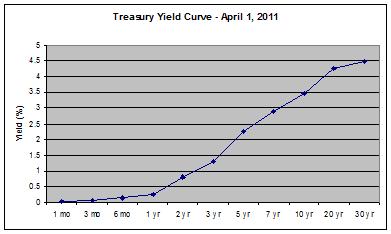The Treasury yield curve, which measures the rate difference between shorter and longer term Treasury securities reached its steepest ever level this morning. A steep yield curve is usually a sign of an economic recovery and an increase in inflation.
The difference between 2- and 10-year Treasury note yields increased to 281.4 basis points before the government announces Dec. 23 how much it plans to auction in 2-, 5- and 7-year securities next week. It rose from 145 basis points at the beginning of the year, with the Federal Reserve anchoring its target rate at virtually zero and the U.S. extending the average maturity of its debt. A report tomorrow is forecast to show the world’s largest economy expanded in the third quarter.
This mirrors the steepening yield curve we have seen in different maturity certificates of deposit.
There are several factors causing such a record difference in the yield curve:
- The Fed is keeping short-term rates low with a Fed Funds rate of 0. The Fed has pegged short term rates to the ground.
- Record government deficits are creating an enormous supply of Treasury Securities. Anytime there is excess supply, the rate goes up to attract more investors.
- Record governmnet deficits are sparking concerns of future inflation. The Treasury is trying to move away from financing the deficit with 2-3 notes and move towards an average maturity of 7-8 years. Investors are going to demand a higher return for longer maturities, especially when there are inflation concerns.
- The economy is improving. An improving economy further adds to inflation concerns.
Many analysts expect the yield curve to steepen further in the next year.






Add your Comment
or use your BestCashCow account